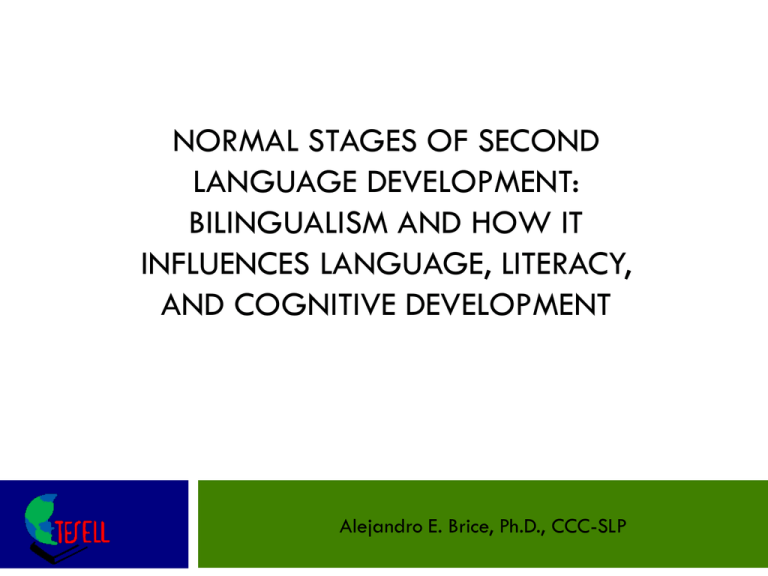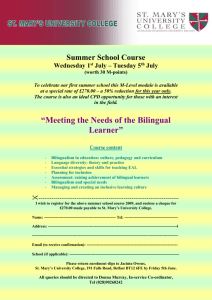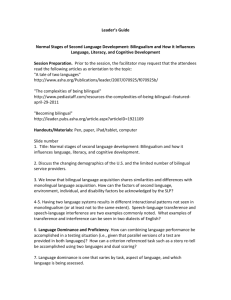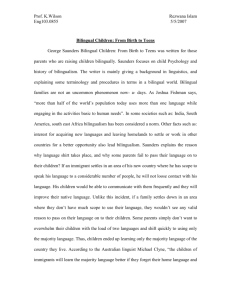code mixing - Training to Enhance Services for English Language
advertisement

NORMAL STAGES OF SECOND LANGUAGE DEVELOPMENT: BILINGUALISM AND HOW IT INFLUENCES LANGUAGE, LITERACY, AND COGNITIVE DEVELOPMENT Alejandro E. Brice, Ph.D., CCC-SLP ASHA Demographic Profile, 2012 • • • Approx. 150,241 certified ASHA members. Estimated that only 5 % of the ASHA membership indicated that they met the criteria for bilingual service provider. Therefore, it is essential that monolingual SLPs know about dual language learners (DLL) in order to assess and treat bilingual students. • • Bilingual acquisition differs from monolingual development (Brice & Brice, 2009). More layers affecting ultimate acquisition include: • Second language acquisition factors • Environmental factors • Individual factors • Disability factors Second Language Acquisition • • • • Second language acquisition is not a straightforward process. The two languages interact with each other even when one language is used primarily. Young children as young as 18 months can code switch when spoken to in L1 or L2 (Döpke, 1992; Pearson, Fernandez, Lewedeg, & Oller, 1997). Language transference- concepts, rules transfer from one language to the other, e.g., /p, b, t, d, k, g/ sounds from Spanish to English. Second Language Acquisition continued • • • Interference- when concepts, rules do not transfer, typically because it may not exist in the native language, e.g., /ɵ,ð/(voiceless and voiced “th”) does not exist in Spanish, therefore, SpanishEnglish speakers will most likely substitute the closest Spanish approximation, an interdental /d/. Other examples of interference include English speakers substituting /d/ for the Spanish tap/flap sound /r/ (as seen in “tener”, deber”). Transference and interference are two way streets, L1->L2, L2->L1. Language Dominance and Proficiency • • • Language dominance and language proficiency are concepts that imply that languages should be considered individually. Proficiency should be investigated in terms of communicative competence (Canale & Swain, 1980; Cazden, John, & Hymes, 1972). Proficiency should be measured utilizing a combined language approach, i.e., both languages must be considered concurrently. It is the sum of all correct responses combined across languages (i.e., correct responses are counted only once regardless of which language) (Castilleja, 2012). • • Bullock, Toribido, González, and Dalola (2006)state that, “Such research contends that bilinguals’ language use is malleable in that they may behave differently according to which language they are producing or perceiving at a given time” (p. 9). Language dominance is not an overall ability assigned to L1, or L2 but one that varies according to language, language domain (e.g., semantics), and task (e.g., reading). Language Maintenance • • Should the parents/caregivers speak the native language or English in the home? Kohnert (2008) stated that in bilingual homes there exists"... the availability of rich language in the environment and diverse opportunities to develop and use a particular language for meaningful communicative interactions" (p. 10). Language Maintenance cont. • • Speaking the native language allows for parents to maintain communication; speaking only English will not accelerate English learning. Children need a strong L1 to transfer those skills to English. It may take longer to acquire English if the native language is not maintained (Thomas & Collier, 1997). Speaking only English at home may provide a less than optimal English model. Language Deceleration • Bilingual children experience extra cognitive and linguistic demands when learning two or more languages (Genesee, 1987). • • This lag is usually temporary with children acquiring native or native-like abilities in oral language skills. Academic language lags have been noted to last after 5-6 years of schooling (Jean & Geva, 2009). Code Switching and Code Mixing • I’m going to read the directions. Prestes atención? (pay attention). • • “Open your books to pagina diez (page ten). These are examples of code switching (CS)(changing languages) and code mixing (CM) (combining languages). • • Both are natural behaviors for bilinguals. Both are rule governed. Conclusions from Brice (2000) • CS and CM occurs with high frequency even in environments where English is preferred. • • Thus, CS and CM appear to be normal and expected behaviors as seen in ESL/ESOL classrooms. CS is more evident than CM. • Most likely due to the fact that switching languages is linguistically simpler than embedding aspects of two languages. Conclusions from Brice (2000) cont. • CM to English is most likely to occur as the students are native language proficient. • • Embedding English word elements into their native language is one stage in English acquisition. Code switching and code mixing are normal occurrences as exhibited by the teacher, teacher paraprofessional and students. Code Switching and Code Mixing cont. • Indicators of possible deficiencies in codeswitching (Brice, 2000): 1. Long pauses indicating word searching and retrieval difficulties, false starts. 2. Inability to switch and mix between the two languages with ease. 3. An over preponderance to use one language, difficulty switching between the two languages. 4. Conscious awareness of which language is being spoken. Ultimate Attainment • • Ultimate attainment abilities depend on robust first language skills (Bialystok, Luk, Peets, & Yang, 2010). Lugo-Neris, Wood-Jackson, and Goldstein (2010) found that children with greater language proficiency in one of their two languages made the most gains from vocabulary intervention. Ultimate Attainment cont. • • Pham and Kohnert (2013) discovered that English vocabulary skills overtook Vietnamese expressive vocabulary skills at 9 and receptive vocabulary skills at 7 ½ years of age. Ultimate attainment in English can be achieved; however, may come at a risk of losing the native language. Language Loss or Attrition • • • Under ideal conditions, balanced bilingualism (i.e., high abilities in both languages) can be achieved. Language loss occurs under less than ideal conditions (Anderson, 1999; Seliger & Vago, 1991). If the home language becomes a minority language (i.e., English becomes the favored and most used language), then serious consequences may occur. (See next page). Language Loss or attrition cont. • When English becomes the favored language, then: 1. The child's language development may stall and resembles a language learning disability. 2. Communication with both parents may weaken. 3. It takes a significantly longer time to fully develop English academic language skills (Thomas & Collier, 1997). 4. Positive transference of language skills from L1 to L2 may be lessened (Cummins, 1984, 1998). Language Fossilization • • • No, not a archaeological dig; but when growth in English languishes and stops (Selinker, 1972). Acquiring English and maintaining the native language are not guaranteed. Several causal factors may influence this outcome: 1. lack of instruction 2. lack of input 3. and/or satisfactory communicative skills (Han, 2004). Environmental Factors According to Wong-Fillmore (1992), bilingualism only occurs when the following conditions are met: 1. Need to communicate 2. Access to speakers of English 3. Interaction, support, feedback from English speakers 4. Adequate time to learn the second language • Individual and Developmental Factors • • Cognitive aptitude, stages in second language learning, and physical development all play a role. Kohnert (2013) states that bilingual students must have the means, opportunities, and motivation to acquire their languages. Disability Factors • The most perplexing question for bilingual children with disabilities is: Are they able to acquire both languages to the best of their abilities? Several studies have a similar pattern of development (Brice & Brice, 2009; Kohnert, Lobitz, & Pham, 2010): 1. Typically developing monolinguals perform better in English. 2. Typically developing bilingual students perform second best. Disability Factors cont. • 3. English speaking children with disabilities perform poorer. 4. Bilingual children with disabilities perform the worst. In conclusion, it appears that the extent of their disability has a more profound effect than their two languages. Strategies for Promoting Bilingualism (Hakuta & Bialystok, 1994) 1. Make learning English a positive experience. 2. Bilingualism should be promoted in the home and school. 3. Children should have well developed native language skills before learning English. 4. Opportunities for reading and writing in the native language should be encouraged. 5. Opportunities to use the native language should be encouraged. Strategies for Promoting Bilingualism cont. • 6. Children should receive appropriate instruction in English. 7. Children should be allowed to make errors. In sum, working with second language learners with and without disabilities will be a challenge. • It is our responsibility to rise up to this challenge. Contact the Author • Alejandro Brice, Ph.D., CCC-SLP Professor, University of South Florida St. Petersburg aebrice@usfsp.edu







